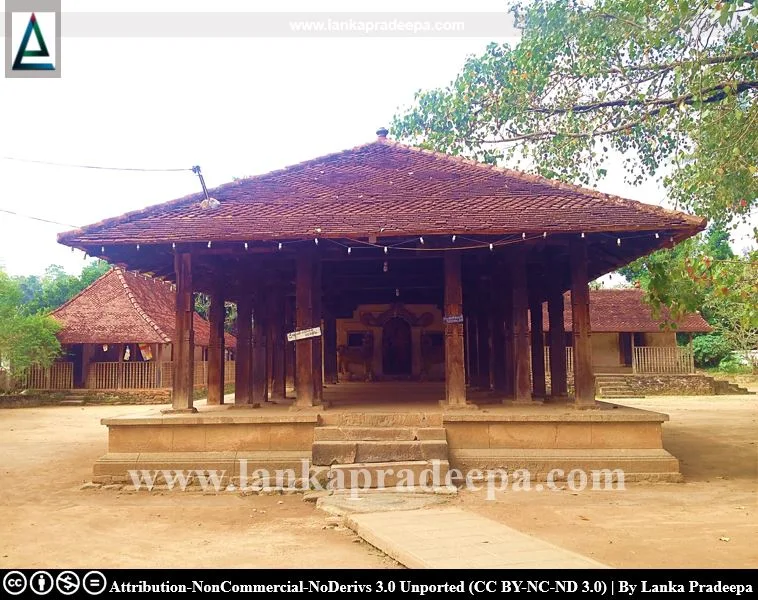
Henakanda Biso Bandara (Sinhala: හෙනකඳ බිසෝ බණ්ඩාර) is believed to be a Queen of King Wikramabahu III (1357-1374 A.D.) of Gampola Kingdom, Sri Lanka (Abeyawardana, 2004). She is credited with the construction or renovation of several prominent Buddhist temples in the country including the famous Embekke Devalaya and Hindagala Viharaya (Abeyawardana, 2004).
The miraculous birth
There are no reliable archaeological or historical sources about Henakanda Biso Bandara but a number of stories in the folklore reveal her existence (Thalwatta, 2017). According to folk tradition, she was born out of a fruit bore on a Beli tree (Aegle marmelos) in Beligala Viharaya in Sathara Korale (Abeyawardana, 2004; Kehelgamuwe, 1935; Thalwatta, 2017). However, the place where this Beli tree was located varies according to the region of the folklore. Some believe that this tree was located in a temple in Mathgamuwa village in Udunuwara or Hendeniya village in Siduruwana (Thalwatta, 2017).
Henakanda Biso Bandara is known among the folk by various names, viz: Lilavati/Nilavati Senkada Biso, Devasena, Gampola Biso Bandara, Sen Khanda Deviya, Henkada Biso, Atasil Biso Adasinnanse (Thalwatta, 2017). Although she was born in a place related to a Buddhist temple, it is believed that she could be a member of an elite family probably a daughter of a concubine of a regional ruler in Beligala (Thalwatta, 2017).
Younger age and her marriage
All folk tales reveal that Henakanda Biso Bandara was a woman of incomparable beauty in her youth. As there are her stories associated with the famous Embekke Devalaya, it is speculated that she may have lived in a place near this temple during her younger ages (Thalwatta, 2017). As she is said to have turned down the many marriage proposals she received, some have begun to identify her as a eunuch woman (Thalwatta, 2017). However, the poetry "Embekke Alankaraya" and the folklore in the Udunuwara region reveal that she was married to King Wikramabahu III (1357-1374 A.D.) of the Gampola Kingdom (Thalwatta, 2017).
The folklore in Kotmale says that she was the consort of a royal or a god named Gange Bandara who lived in that area (Thalwatta, 2017).
The controversial death
According to folklore, God Kataragama who was mesmerized by the beauty of Henakanda Biso Bandara tried to take her but she avoided him and left for Kotmale and settled in an area called Meddegoda near Morape (Read the story of Morape Kataragama Devalaya). It is said that, as she was constantly trying to avoid God Kataragama, he killed her at the place called Sevendarapitiya while she was travelling in her palanquin (Thalwatta, 2017). However, this killing incident varies in the folklore in different regions. According to them, the killer of Henakanda Biso Bandara is not God Kataragama but either Gange Bandara or King Wikramabahu III (Thalwatta, 2017). According to another story, her death occurred due to a heart attack (Thalwatta, 2017).
It is believed that after her death, which happened at Sevandarapitiya, the body was placed in a trough made of Kahata and buried on the bank of Kotmale Oya (Thalwatta, 2017). On the same day of the burial, heavy rain caused the river bank along with the trough breaks into the Kotmale Oya and then into the Mahaweli Ganga River (Thalwatta, 2017). The trough which was floated on the river was finally stranded at the place called Vakkalama in Bothalapitiya (Thalwatta, 2017). It is said that the place where the log was cut for the trough was later named Kahatadena and the spot from where the trough containing her dead body was recovered was called Kahatapitiya (Abeyawardana, 2004; Kehelgamuwe, 1935). The famous Muslim shrine Kahatapitiya Mosque is believed to have been erected at this spot in Gampola and presently Henakanda Biso Bandara is venerated at this Muslim shrine as a powerful god without any religious discrimination (Abeyawardana, 2004).
The annual procession of Embekke Devalaya is conducted in the manner of a funerary procession unlike any other Devalas in the country (Gamage, 2018). This procession honours the memory of Henakanda Biso Bandara and concludes with the annual water-cutting ceremony (Gamage, 2018). Also, there was an ancient wooden statue of Henakanda Biso Bandara in Wegama Raja Maha Viharaya but it was destroyed later by treasure hunters.
See also
References
1) Abeyawardana, H.A.P., 2004. Heritage of Kandurata: Major natural,
cultural and historic sites. Colombo: The Central Bank of Sri Lanka. pp.68,231.
2) Gamage, L. S., 2018. The Dwelling of the War God: the Art and Architecture of Embekke Devāle in Medieval and Early Modern Sri Lanka (Doctoral dissertation, University of California, Los Angeles). p.25.
2) Gamage, L. S., 2018. The Dwelling of the War God: the Art and Architecture of Embekke Devāle in Medieval and Early Modern Sri Lanka (Doctoral dissertation, University of California, Los Angeles). p.25.
3) Kehelgamuwe, P.B., 1935. Kotmale Puravrutha (In Sinhala). pp.43-44.
4) Thalwatta, A., 2017. ජනශ්රැතිය මගින් නිරූපිත හෙණකඳ බිසෝ බණ්ඩාර දේවිය (In Sinhala). Sarathi. Department of Cultural Affairs: Central Province. ISSN: 22792414. pp.1-9.
This page was last updated on 5 May 2023

